Wistron MS2146 Notebook PC w/802.11b module WM3B2100 User Manual AJC e
Wistron Corporation Notebook PC w/802.11b module WM3B2100 AJC e
Wistron >
Contents
Part 3
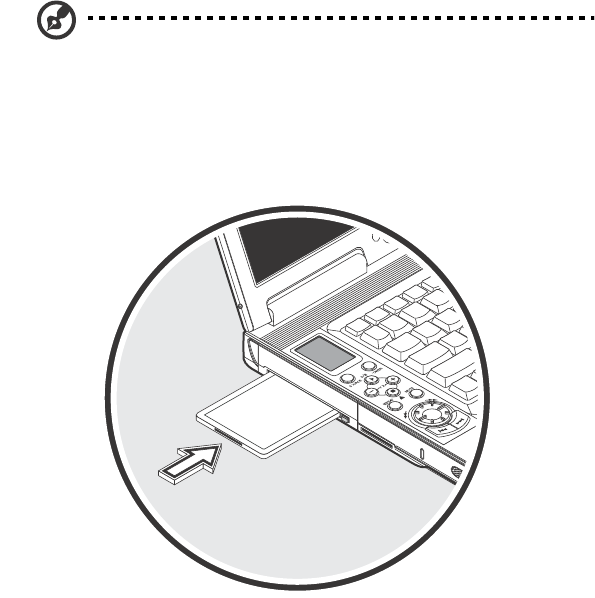
55
PC Card
The computer has a built-in CardBus PC Card slot that can accommodate one type
II PC Card. Please consult your dealer for PC Card options available that you can
purchase for your computer.
PC Card slot
The type II CardBus PC Card slot found on the left panel of the computer accepts
credit-card-sized cards that enhance the usability and expandability of the
computer.
PC Cards (formerly PCMCIA) are add-on cards for portable computers, giving
you expansion possibilities long afforded by desktop PCs. Popular type II cards
include flash memory, SRAM, fax/data modem, LAN and SCSI cards. CardBus
improves on the 16-bit PC card technology by expanding the data path to 32 bits.
Note: Refer to your card’s manual for details on how to install and use the
card and its functions.
Inserting a card
Insert the card into the slot and make the proper connections (e.g., network cable),
if necessary. See your card manual for details.
AJC-e.book Page 55 Wednesday, September 3, 2003 1:48 PM
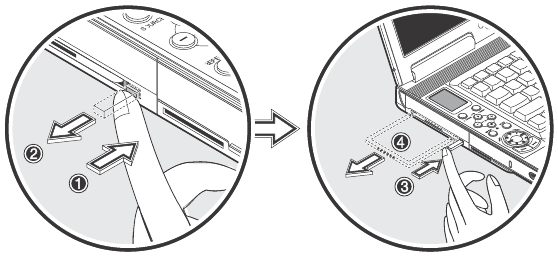
3 Peripherals and options56
Ejecting a card
Before ejecting a PC Card:
• Exit the application using the card.
• Left-click on the PC Card icon on the taskbar and stop the card operation.
Press the slot eject button once to pop it out; then press it again to eject the PC
Card.
AJC-e.book Page 56 Wednesday, September 3, 2003 1:48 PM
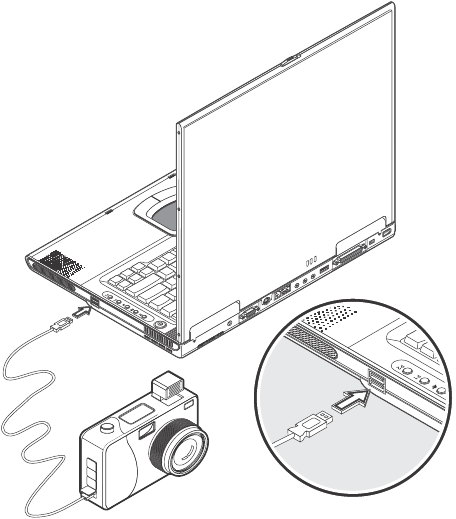
57
USB devices
The computer has two USB (Universal Serial Bus) (2.0) ports that allow you to
connect peripherals without occupying too many resources. Common USB
devices include a mouse, keyboard, and digital camera.
AJC-e.book Page 57 Wednesday, September 3, 2003 1:48 PM
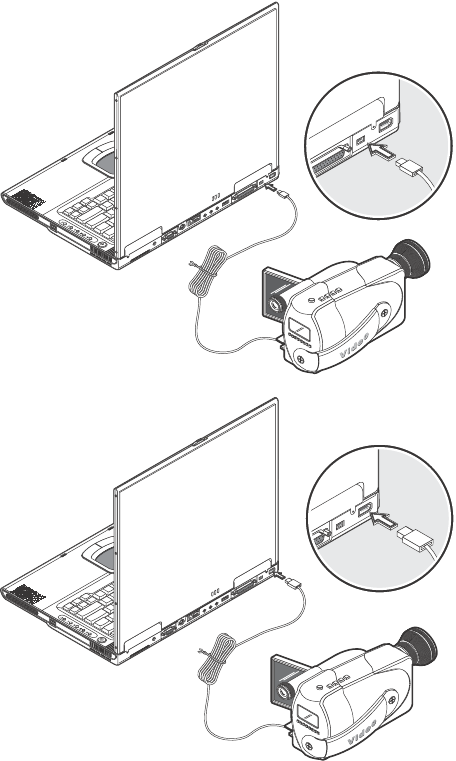
3 Peripherals and options58
IEEE 1394 devices
The computer's fast IEEE 1394 port allows you to connect IEEE 1394 supported
devices like a digital video camera or optical drive. The computer comes with 2
kind of IEEE 1394 ports, 4-pin and 6-pin for more flexibility.
See your peripheral's documentation for details.
AJC-e.book Page 58 Wednesday, September 3, 2003 1:48 PM
59
Miscellaneous options
Additional power packs
You can order an AC adapter and spare batteries.
Battery pack
It is a good practice to have a spare battery around, especially when you travel.
The Li-ion battery, coupled with the power management features of your
computer, supplies you with more power on-the-go.
You can also purchase a secondary battery pack to install in the module bay.
AC adapter
The compact AC adapter charges your battery pack and supplies power to your
computer. You can order a spare AC adapter so you do not need to carry it from
the office to your home or destination.
AJC-e.book Page 59 Wednesday, September 3, 2003 1:48 PM

3 Peripherals and options60
Key component upgrades
Your computer delivers superior power and performance. However, some users
and the applications they use may demand more. This computer allows you to
upgrade key components when you need increased performance.
Note: Contact your authorized dealer if you decide to perform a key
component upgrade.
Memory upgrade
This notebook computer comes with two DDR-266 SoDIMM (Small Outline Dual
Inline Memory Module) sockets that accepts 128/256/512 MB Synchronous
Dynamic Random Access Memory (SDRAM) module. Please consult your dealer
if you need to add more memory.
Hard disk upgrade
It is possible to upgrade your hard disk with a higher capacity drive when you need
more storage space. The computer uses a 9.5mm 2.5-inch Enhanced-IDE hard
disk. Please consult your dealer if you need to upgrade your hard disk.
AJC-e.book Page 60 Wednesday, September 3, 2003 1:48 PM

4 Moving with your
computer
AJC-e.book Page 61 Wednesday, September 3, 2003 1:48 PM

This chapter gives you tips and hints on things to
consider when moving around or traveling with
your computer.
AJC-e.book Page 62 Wednesday, September 3, 2003 1:48 PM
63
Disconnecting from the desktop
Follow these steps to disconnect your computer from external accessories:
1. Save your work in progress.
2. Shut down the operating system.
3. Turn off the computer.
4. Disconnect the cord from the AC adapter.
5. Disconnect the keyboard, pointing device, printer, external monitor, and other
external devices.
6. Disconnect the Kensington lock if you are using one to secure the computer.
Moving around
when you are just moving within short distances, for example, from your office
desk to a meeting room
Preparing the computer
Before moving the computer, close and latch the display cover to place it in
Standby mode. You can now safely take the computer anywhere you go within the
building.
To bring the computer out of Standby mode, open the display.
What to bring to short meetings
A fully charged battery runs the computer for 4.5 hours under most circumstances.
If your meeting is shorter than that, you probably do not need to bring anything
with you other than the computer.
What to bring to long meetings
If your meeting will last longer than 4.5 hours or if your battery is not fully
charged, you may want to bring the AC adapter with you to plug in your computer
in the meeting room.
If the meeting room does not have an electrical outlet, reduce the drain on the
battery by putting the computer in sleep mode. Press Fn-F2 or close the display
cover whenever you are not actively using the computer. Then tap any key or open
the display to resume.
Taking the computer home
when you are moving from your office to your home or vice versa
AJC-e.book Page 63 Wednesday, September 3, 2003 1:48 PM

4 Moving with your computer64
Preparing the computer
After disconnecting the computer from your desktop, follow these steps to prepare
the computer for the trip home:
1. Remove all media from the drives. Failure to remove the media can damage
the drive head.
2. Pack the computer in a protective case that can prevent the computer from
sliding around and cushion it if it should fall.
Caution: Avoid packing items next to the top cover of the computer.
Pressure against the top cover could damage the screen.
What to bring with you
Unless you already have some items at home, bring the following items with you:
• AC adapter and power cord
• The printed user’s manual
Special considerations
Follow these guidelines to protect your computer while traveling to and from
work:
• Minimize the effect of temperature changes by keeping the computer with
you.
• If you need to stop for an extended period of time and cannot bring the
computer with you, leave the computer in the trunk of the car to avoid
exposing the computer to excessive heat.
• Changes in temperature and humidity can cause condensation. Allow the
computer to return to room temperature, and inspect the screen for
condensation before turning on the computer. If the temperature change is
greater than 18°F (10°C), allow the computer to come to room temperature
slowly. If possible, leave the computer for 30 minutes in an environment with
a temperature between outside and room temperature.
Setting up a home office
If you frequently work on your computer at home, it may be worthwhile to
purchase a second AC adapter for use at home. With a second AC adapter, you
can avoid transporting the extra weight to and from home.
AJC-e.book Page 64 Wednesday, September 3, 2003 1:48 PM
65
If you use your computer at home for significant periods of time, you might also
want to add an external keyboard, monitor, or mouse.
Traveling with the computer
when you are moving within a larger distance, for instance, from your office
building to a client’s office building or traveling locally
Preparing the computer
Prepare the computer as if you were taking it home. Be sure the battery in the
computer is charged. Airport security may require you to turn on your computer
when bringing it into the gate area.
What to bring with you
Bring the following items with you:
• AC adapter
• Spare, fully charged battery packs
• Additional printer driver files if you plan to use another printer
Special considerations
In addition to the guidelines for taking the computer home, follow these guidelines
to protect your computer while traveling:
• Always take the computer as carry-on luggage.
• If possible, have the computer inspected by hand. The computer can safely
pass through security X-ray machines, but never expose the computer to a
metal detector.
• Avoid exposing floppy disks to hand-held metal detectors.
Traveling internationally with the
computer
when you are moving from country to country
Preparing the computer
Prepare the computer as you would normally prepare it for traveling.
AJC-e.book Page 65 Wednesday, September 3, 2003 1:48 PM
4 Moving with your computer66
What to bring with you
Bring the following items with you.
•AC adapter
• Power cords that are appropriate to the country to which you are traveling
• Spare, fully charged battery packs
• Additional printer driver files if you plan to use another printer
Special considerations
Follow the same special considerations as when traveling with the computer. In
addition, these tips are useful when traveling internationally.
• When traveling in another country, check that the local AC voltage and the
AC adapter power cord specifications are compatible. If not, purchase a
power cord that is compatible with the local AC voltage (e.g., power rating).
Do not use converter kits sold for appliances to power the computer.
• If you are using the modem, check if the modem and connector is compatible
with the telecommunication system of the country you are traveling in.
AJC-e.book Page 66 Wednesday, September 3, 2003 1:48 PM

5 Software
AJC-e.book Page 67 Wednesday, September 3, 2003 1:48 PM

This chapter discusses the important system utilities
bundled with your computer.
AJC-e.book Page 68 Wednesday, September 3, 2003 1:48 PM

69
System software
The computer comes preloaded with the following software:
• Windows operating system
• DMI (Desktop Management Interface)-compliant hardware BIOS utility
• System utilities, drivers and application software
Note: To access Windows software applications, click on the Start button and
select the application folder. Then click on the application icon to run the
selected application. To learn about the software and utility, make use of the
online help provided by the software.
AJC-e.book Page 69 Wednesday, September 3, 2003 1:48 PM
5 Software70
Launch Manager
Launch Manager allows you to set the four launch keys and the wireless button
located above the keyboard. See “Launch keys” on page 23 for the location of
these keys.
You can access the Launch Manager by clicking on Start, Programs, and then
Launch Manager to start the application.
AJC-e.book Page 70 Wednesday, September 3, 2003 1:48 PM
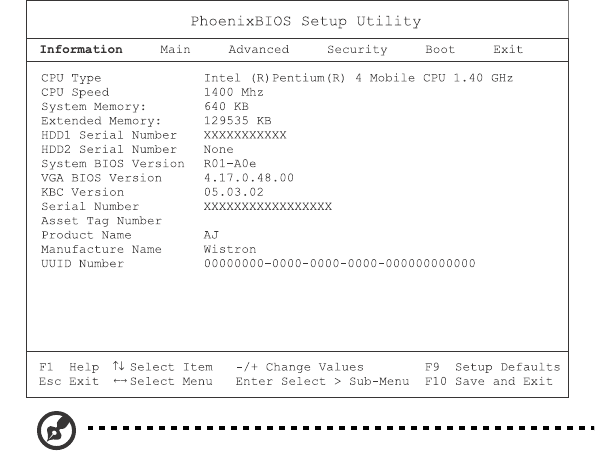
71
BIOS Utility
The BIOS Utility is a hardware configuration program built into your computer’s
BIOS (basic input/output system).
Your computer is already properly configured and optimized, and you do not need
to run this utility. However, if you encounter configuration problems, you may
need to run it. Please also refer to Chapter 6, Troubleshooting when a problem
arises.
To activate the BIOS Utility, press F2 during POST.
Note: The screen above is for reference only. Actual values may differ.
Navigating the BIOS Utility
These are the menu options: Information, Main, Advanced, Security, Boot and
Exit.
To enter a menu, highlight the item using the ← → keys.
Within a menu, navigate through the BIOS Utility by following these instructions:
• Press the cursor up/down keys (↑↓) to select item.
• Press the F5/F6 to change the value of a parameter.
•Press Enter to go to sub-menu.
•Press Esc while you are in any of the menu options to return to the main menu
AJC-e.book Page 71 Wednesday, September 3, 2003 1:48 PM
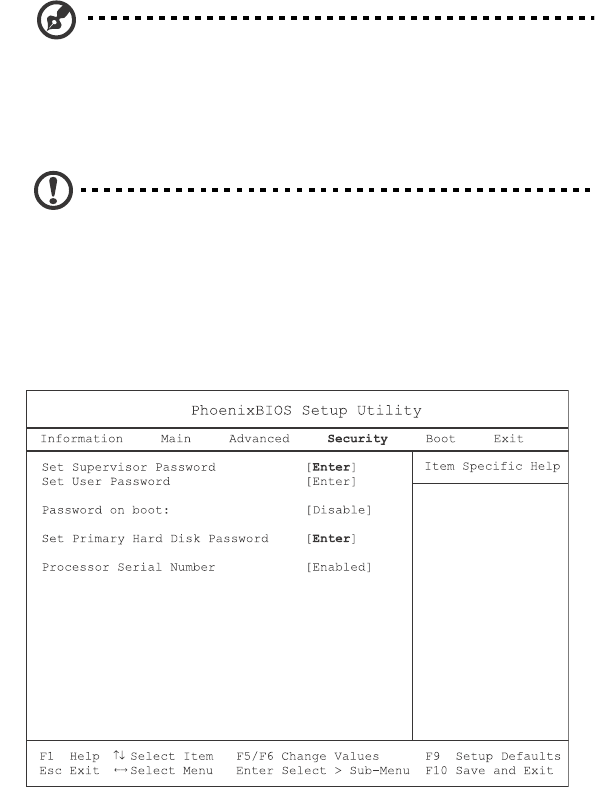
5 Software72
Note: You can change the value of a parameter if it is enclosed in square
brackets. Navigation keys for a particular menu are shown on the bottom of
the screen.
When you select an item in the BIOS Utility, the function description will appear
at the right side of the screen.
Caution: Some parameters in the BIOS Utility screens are for advanced
users only. Typically, you do not need to change the values in the screen
because these values are already optimized.
Security
The System Security screen contains parameters that help safeguard and protect
your computer from unauthorized use.
AJC-e.book Page 72 Wednesday, September 3, 2003 1:48 PM
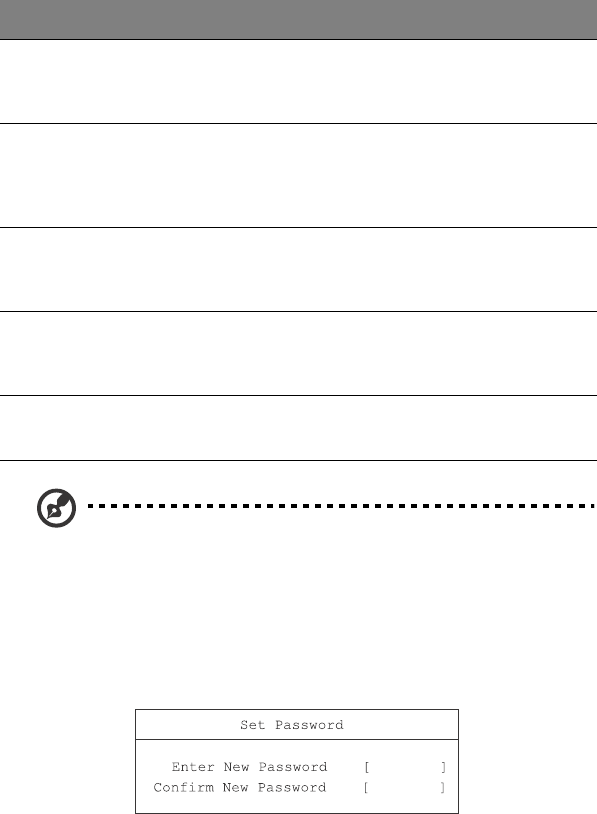
73
The table below describes the parameters in this screen. Settings in boldface are
the default and suggested parameter settings.
Note: Don’t forget your password. If you forget your password, you
may have to return your notebook computer to your dealer to reset it.
Setting a password
Follow these steps:
1. Use the ↑ and ↓ keys to highlight a password parameter (Supervisor, User,
Boot, or Hard Disk) and press the Enter key. The password box appears:
2. Type a password. The password may consist of up to eight alphanumeric
characters (A-Z, a-z, 0-9). Press Enter.
Parameter Description
Setup Supervisor
Password
When set, this password protects the BIOS Utility from
unauthorized entry, and protects critical BIOS parameters.
Press Enter to set this password.
Set User Password When set, this password protects the computer from
unauthorized entry during boot-up or resume from Hibernation
mode.
Press Enter to set this password.
Password on Boot When enabled, a password is requested when the system boots
up.
Options: Enabled or Disabled
Set Primary Hard
Disk Password
When set, this password prevents the primary hard disk from
unauthorized access. It consists of 8 alphanumeric characters.
Press Enter to set this password.
Processor Serial
Number
Controls detection of processor serial number.
Options: Enabled or Disabled
AJC-e.book Page 73 Wednesday, September 3, 2003 1:48 PM
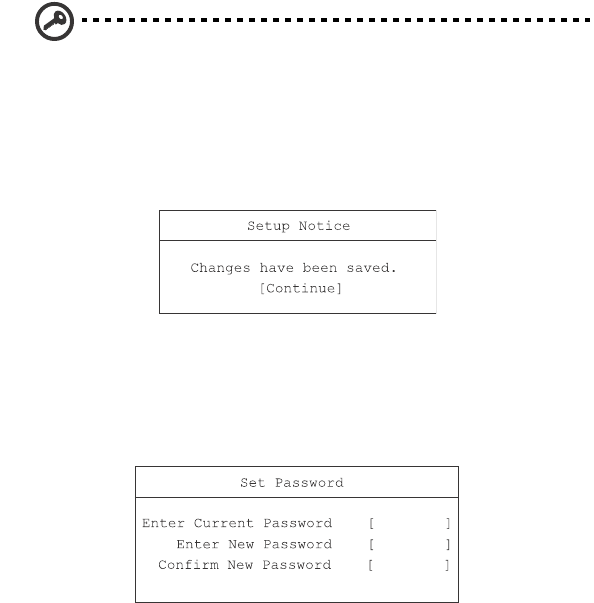
5 Software74
Important: Be very careful when typing your password because the
characters do not appear on the screen.
3. Retype the password to verify your first entry and press Enter.
After setting the password, the computer automatically sets the chosen
password parameter to Present and a dialog box appears confirming the
changes.
4. Press Esc to return to the main menu.
Changing a password
To change a password, follow the steps in “Setting a password” on page 73. Enter
the current password and then enter a new password.
Removing a password
To remove a password, follow the steps in “Setting a password” on page 73. Enter
the current password and then leave the Enter New Password and Confirm New
Password blank.
AJC-e.book Page 74 Wednesday, September 3, 2003 1:48 PM
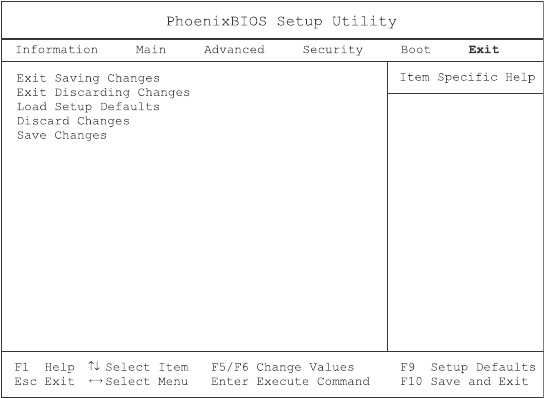
75
Exit
To exit the BIOS Utility, go the Exit screen and choose an item and press Enter.
Press Enter again to confirm the selection.
AJC-e.book Page 75 Wednesday, September 3, 2003 1:48 PM
5 Software76
AJC-e.book Page 76 Wednesday, September 3, 2003 1:48 PM

6 Troubleshooting
AJC-e.book Page 77 Wednesday, September 3, 2003 1:48 PM

This chapter instructs you on how to deal with
common system problems. Read it before calling a
technician if a problem occurs. Solutions to more
serious problems require opening up the computer.
Do not attempt to open and service the computer by
yourself. Contact your dealer or an authorized
service center for assistance.
AJC-e.book Page 78 Wednesday, September 3, 2003 1:48 PM
79
Frequently-asked questions
This is a list of possible situations that may arise during the use of your computer,
and it gives easy answers and solutions to these questions.
I press the power switch, but the computer does not start or boot-up.
Look at the Power indicator:
• If it is not lit, no power is being applied to the computer. Check the
following:
• If you are running on battery power, it may be low and unable to power
the computer. Connect the AC adapter to recharge the battery pack.
• Make sure the AC adapter is plugged in properly to the computer and to
the power outlet.
• If it is lit, check the following:
• If the Standby indicator is lit, the computer is in Standby mode. Press
any key or tap on the touchpad to resume.
• Is a non-bootable (non-system) diskette in the floppy drive? Remove or
replace it with a system diskette and press Ctrl-Alt-Del to restart the
system.
The operating system files may be damaged or missing. Insert the startup disk you
created during Windows setup into the floppy drive and press Ctrl-Alt-Del to
restart the system. This will diagnose your system and make necessary fixes.
Nothing appears on the screen.
The computer’s power management system automatically blanks the screen to
save power. Press any key to turn the display back on.
If pressing a key does not turn the display back on, two things might be the cause:
• The brightness level might be too low. Press Fn-← and Fn-→ to adjust the
brightness level.
• The display device might be set to an external monitor. Press the display
toggle hot key Fn-F3 to toggle the display back to the computer.
Image is not full-screen.
Make sure the resolution is set to a resolution your system supports. Right-click
on your Windows desktop and select Properties to bring up the Display Properties
dialog box. Then click on the Settings tab to make sure the resolution is set to the
appropriate resolution. Resolutions lower than the specified resolution are not
full-screen on the computer or on an external monitor.
AJC-e.book Page 79 Wednesday, September 3, 2003 1:48 PM
6 Troubleshooting80
No audio from the computer.
Check the following:
• The volume may be muted. In Windows, look at the volume control icon on
the taskbar. If it is crossed-out, click on the icon and deselect the Mute
option.
• The speakers may be turned off. Press Fn-F5 to turn the speakers on (this
hotkey also turns the speakers off).
• The volume level may be too low. In Windows, look at the volume control
icon on the taskbar. Click on the icon and adjust the level.
If headphones, earphones or external speakers are connected to the line-out port on
the computer’s rear panel, the internal speakers automatically turn off.
External microphone does not work.
Check the following:
• Make sure the external microphone is connected to the microphone-in jack on
the computer’s rear panel.
• If you cannot hear playback, the speakers may be muted.
The keyboard does not respond.
Try attaching an external keyboard to the USB connector on the computer’s rear.
If it works, contact your dealer or an authorized service center as the internal
keyboard cable may be loose.
The printer does not work.
Check the following:
• Make sure that the printer is connected to a power outlet and it is turned on.
• Make sure the printer cable is connected securely to the computer’s port and
the corresponding port on the printer.
I want to set up my location to use the internal modem.
To properly use your communications software (e.g., HyperTerminal), you need to
set up your location:
1. Open the Windows Control Panel and double-click on the Modems icon.
2. Click on Dialing Properties and begin setting up your location.
Refer to the Windows manual.
Why can’t I charge my battery to 100% charged when it is 99-95%
AJC-e.book Page 80 Wednesday, September 3, 2003 1:48 PM
81
charged?
To preserve the life of the battery, the system only lets you charge the battery when
its capacity falls below 95%. However, it is recommended that you bring an extra
battery and let the battery in the system use up its power before charging it.
AJC-e.book Page 81 Wednesday, September 3, 2003 1:48 PM
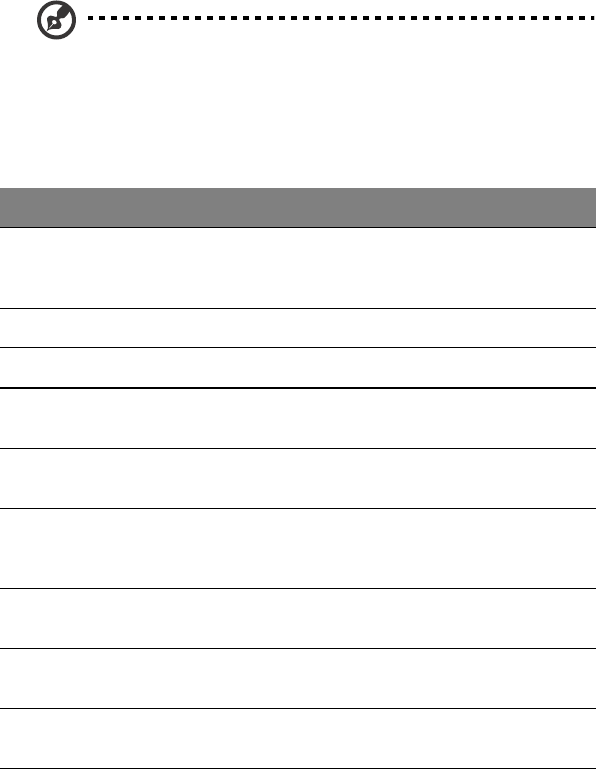
6 Troubleshooting82
Error messages
The following is a list of the messages that the BIOS can display. Most of them
occur during POST. Some of them display information about a hardware device,
e.g., the amount of memory installed. Others may indicate a problem with a
device, such as the way it has been configured. Following the list are explanations
of the messages and remedies for reported problems.
Note: If your system displays one of the messages marked below with an
asterisk (*), write down the message and contact your dealer. If your system
fails after you have made the changes in the Setup menus, reset the computer,
enter Setup and load the Setup defaults to correct the error.
Error Messages Corrective Action
0200 Failure Fixed Disk Fixed disk is not working or not configured properly.
Check to see if fixed disk is attached properly. Run Setup.
Find out if the fixed-disk type is correctly identified.
0210 Stuck key Stuck key on keyboard.
0211 Keyboard error Keyboard not working.
0212 Keyboard Controller
Failed*
Keyboard controller failed test. May require replacing
keyboard controller.
0213 Keyboard locked -
Unlock key switch
Unlock the system to proceed.
0220 Monitor type does not
match CMOS - Run
SETUP
Monitor type not correctly identified in Setup
0230 Shadow Ram Failed
at offset: nnnn*
Shadow RAM failed at offset nnnn of the 64k block at
which the error was detected.
0231 System RAM Failed
at offset: nnnn*
System RAM failed at offset nnnn of in the 64k block at
which the error was detected.
0232 Extended RAM
Failed at offset: nnnn*
Extended memory not working or not configured properly
at offset nnnn.
AJC-e.book Page 82 Wednesday, September 3, 2003 1:48 PM
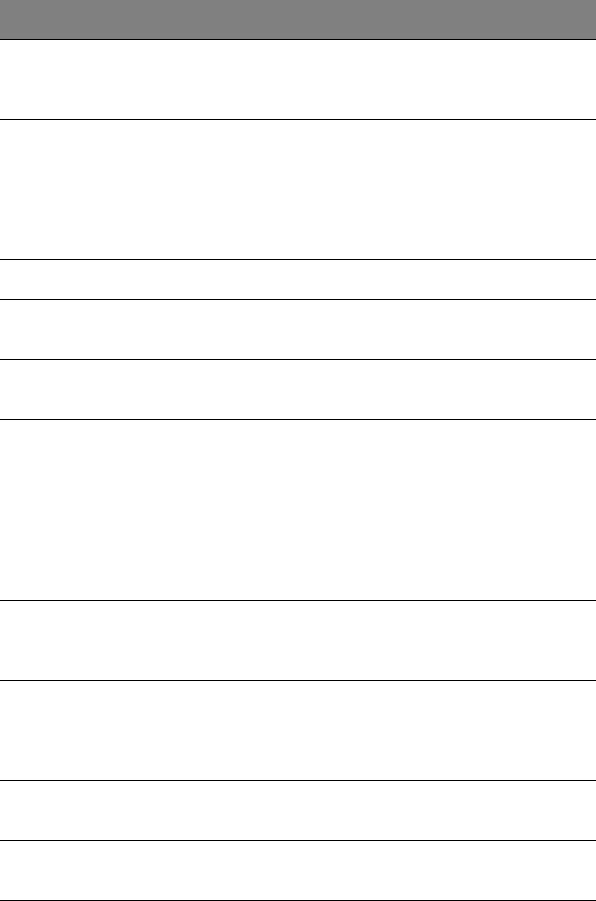
83
0250 System battery is
dead - Replace and run
SETUP
The CMOS clock battery indicator shows the battery is
dead. Replace the battery and run Setup to reconfigure the
system.
0251 System CMOS
checksum bad - Default
configuration used
System CMOS has been corrupted or modified
incorrectly, perhaps by an application program that
changes data stored in CMOS. The BIOS installed
Default Setup Values. If you do not want these values,
enter Setup and enter your own values. If the error
persists, check the system battery or contact your dealer.
0260 System timer error* The timer test failed. Requires repair of system board.
0270 Real time clock
error*
Real-Time Clock fails BIOS hardware test. May require
board repair.
0271 Check date and time
settings
BIOS found date or time out of range and reset the Real-
Time Clock. May require setting legal date (1991-2099).
0280 Previous boot
incomplete - Default
configuration used
Previous POST did not complete successfully. POST
loads default values and offers to run Setup. If the failure
was caused by incorrect values and they are not corrected,
the next boot will likely fail. On systems with control of
wait states, improper Setup settings can also terminate
POST and cause this error on the next boot. Run Setup
and verify that the wait-state configuration is correct. This
error is cleared the next time the system is booted.
0281 Memory Size found
by POST differed from
CMOS
Memory size found by POST differed from CMOS.
02B0 Diskette drive A
error
02B1 Diskette drive B error
Drive A: or B: is present but fails the BIOS POST diskette
tests. Check to see that the drive is defined with the
proper diskette type in Setup and that the diskette drive is
attached correctly.
02B2 Incorrect Drive A
type - run SETUP
Type of floppy drive A: not correctly identified in Setup.
02B3 Incorrect Drive B
type - run SETUP
Type of floppy drive B: not correctly identified in Setup.
Error Messages Corrective Action
AJC-e.book Page 83 Wednesday, September 3, 2003 1:48 PM
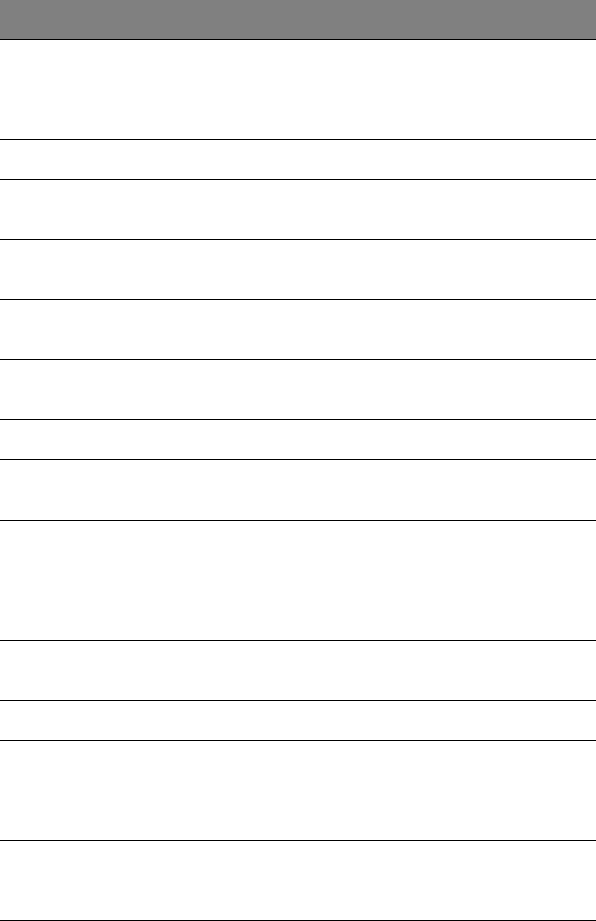
6 Troubleshooting84
02D0 System cache error -
Cache disabled
RAM cache failed and BIOS disabled the cache. On older
boards, check the cache jumpers. You may have to
replace the cache. See your dealer. A disabled cache
slows system performance considerably.
02F0: CPU ID: CPU socket number for Multi-Processor error.
02F4: EISA CMOS not
writeable*
ServerBIOS2 test error: Cannot write to EISA CMOS.
02F5: DMA Test Failed* ServerBIOS2 test error: Cannot write to extended DMA
(Direct Memory Access) registers.
02F6: Software NMI
Failed*
ServerBIOS2 test error: Cannot generate software NMI
(Non-Maskable Interrupt).
02F7: Fail-Safe Timer NMI
Failed*
ServerBIOS2 test error: Fail-Safe Timer takes too long.
device Address Conflict Address conflict for specified device.
Allocation Error for: device Run ISA or EISA Configuration Utility to resolve
resource conflict for the specified device.
Failing Bits: nnnn* The hex number nnnn is a map of the bits at the RAM
address which failed the memory test. Each 1 (one) in the
map indicates a failed bit. See errors 230, 231, or 232
above for offset address of the failure in System,
Extended, or Shadow memory.
Invalid System
Configuration Data
Problem with NVRAM (CMOS) data.
I/O device IRQ conflict I/O device IRQ conflict error.
One or more I2O Block
Storage Devices were
excluded from the Setup
Boot Menu
There was not enough room in the IPL table to display all
installed I2O block-storage devices.
Operating system not found Operating system cannot be located on either drive A: or
drive C:. Enter Setup and see if fixed disk and drive A:
are properly identified.
Error Messages Corrective Action
AJC-e.book Page 84 Wednesday, September 3, 2003 1:48 PM
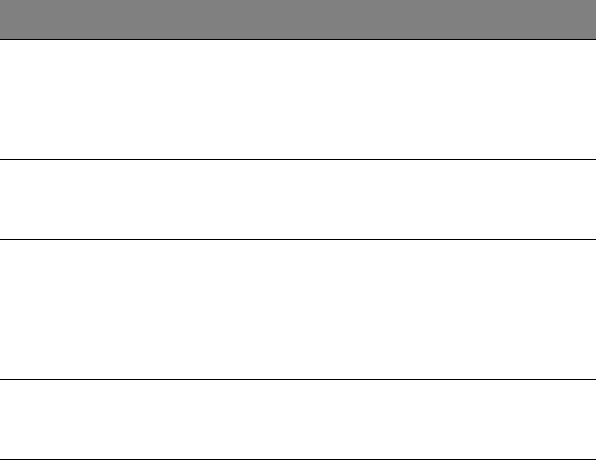
85
If you still encounter problems after going through the corrective measures, please
contact your dealer or an authorized service center for assistance. Some problems
may be solved using the BIOS Setup Utility. See “BIOS Utility” on page 71.
Parity Check 1 nnnn* Parity error found in the system bus. BIOS attempts to
locate the address and display it on the screen. If it cannot
locate the address, it displays nnnn. Parity is a method for
checking errors in binary data. A parity error indicates
that some data has been corrupted.
Parity Check 2 nnnn* Parity error found in the I/O bus. BIOS attempts to locate
the address and display it on the screen. If it cannot locate
the address, it displays nnnn.
Press <F1> to resume,
<F2> to Setup, <F3> for
previous
Displayed after any recoverable error message. Press
<F1> to start the boot process or <F2> to enter Setup and
change the settings. Press <F3> to display the previous
screen (usually an initialization error of an Option ROM,
i.e., an add-on card). Write down and follow the
information shown on the screen.
Run the I2O Configuration
Utility
One or more unclaimed block storage devices have the
Configuration Request bit set in the LCT. Run an I2O
Configuration Utility (e.g. the SAC utility).
Error Messages Corrective Action
AJC-e.book Page 85 Wednesday, September 3, 2003 1:48 PM
6 Troubleshooting86
AJC-e.book Page 86 Wednesday, September 3, 2003 1:48 PM

A Specifications
AJC-e.book Page 87 Wednesday, September 3, 2003 1:48 PM

This appendix lists the general specifications
of your computer.
AJC-e.book Page 88 Wednesday, September 3, 2003 1:48 PM
89
Microprocessor
• Mobile Intel® Pentium™ Processor-M with Enhanced Intel® SpeedStep™
technology
Memory
• Onboard memory upgradable to 2048 MB with 2 DDR-266/333 SoDIMM
• 1 MB (1024K) on-die L2 cache
Data storage
• One high-capacity, Enhanced-IDE hard disk
• Slot-loading DVD/CD-RW combo drive
• Secure Digital (SD) slot
• Optional second hard disk module
Display and video
• 15.4” 16:10 SXGA (Super eXtended Graphic Array) widescreen TFT LCD
panel
• 1280x800 (SXGA) resolution, 16.7 million colors
• ATI® Mobility™ Radeon™ 9600 high-performance graphics chipset with
64MB frame buffer
• Simultaneous LCD and CRT display
• Dual display support
• LCD panel supports resolution up to 2048x1536
• VGA monitor supports resolution up to 2048x1536
• Embedded TV encoder supports resolution up to 1024x768
Audio
• Built-in speaker and microphone
• Sound Blaster Pro- and Windows Sound System-compatible
• Separate audio ports for line-in/microphone-in and line-out (S/PDIF) devices
Keyboard and pointing device
• 84-/85-/88-key Windows keyboard
• Ergonomically-centered touchpad pointing device
AJC-e.book Page 89 Wednesday, September 3, 2003 1:48 PM
A Specifications90
I/O ports
• One type II/I CardBus PC Card slot
• One RJ-11 phone jack (V.90) for modem
• One RJ-45 network jack (Ethernet 10/100)
• One DC-in jack
• One Printer port
• One external monitor port (DDC 2.0)
• One S-video output port
• One line-out jack (S/PDIF) (3.5mm mini-jack)
• One line-in (3.5mm mini-jack)
• One microphone-in jack (3.5mm mini-jack)
• USB (Universal Serial Bus) ports (2.0)
• 2 IEEE 1394 ports (one mini port and one regular port)
• One SD slot
Weight and dimensions
• 3.2 kg (7.1 lbs)
• 354 x 255 x 35 mm (13.93 x 10.04 x 1.38 in.)
Environment
•Temperature
• Operating: 5°C ~ 35°C
• Non-operating: -10°C ~ 65°C
• Humidity (non-condensing)
• Operating: 20% ~ 80% RH
• Non-operating: 20% ~ 80% RH
System
• Windows XP
Power
• Battery pack
• 59.2-WattHour Li-Ion battery pack
AJC-e.book Page 90 Wednesday, September 3, 2003 1:48 PM
91
• 2.5-hour rapid charge
• AC adapter
•70-Watt
• Auto sensing 100~240Vac, 50~60Hz
Options
• 128/256/512 MB DDR 266 SoDIMM memory upgrade module
• Additional AC adapter
• Secondary hard disk module
• Subwoofer module
• Secondary battery
• Tray-type DVD drive
• Tray-type Combo drive (DVD/CD-RW)
• Slot-in DVD-Multi drive (Combo/DVD-RAM/DVD-RW)
AJC-e.book Page 91 Wednesday, September 3, 2003 1:48 PM
A Specifications92
AJC-e.book Page 92 Wednesday, September 3, 2003 1:48 PM

B Notices
AJC-e.book Page 93 Wednesday, September 3, 2003 1:48 PM

This appendix lists the general notices of
your computer.
AJC-e.book Page 94 Wednesday, September 3, 2003 1:48 PM
95
FCC notice
This device has been tested and found to comply with the limits for a Class B
digital device pursuant to Part 15 of the FCC Rules. These limits are designed to
provide reasonable protection against harmful interference in a residential
installation. This device generates, uses, and can radiate radio frequency energy
and, if not installed and used in accordance with the instructions, may cause
harmful interference to radio communications.
However, there is no guarantee that interference will not occur in a particular
installation. If this device does cause harmful interference to radio or television
reception, which can be determined by turning the device off and on, the user is
encouraged to try to correct the interference by one or more of the following
measures:
1. Reorient or relocate the receiving antenna
2. Increase the separation between the device and receiver
3. Connect the device into an outlet on a circuit different from that to which the
receiver is connected
4. Consult the dealer or an experienced radio/television technician for help
Notice: shield cables
All connections to other computing devices must be made using shielded cables to
maintain compliance with FCC regulations.
Notice: peripheral devices
Only peripherals (input/output devices, terminals, printers, etc.) certified to
comply with the Class B limits may be attached to this equipment. Operation with
non-certified peripherals is likely to result in interference to radio and TV
reception.
Caution
Changes or modifications not expressly approved by the manufacturer could void
the user’s authority, which is granted by the Federal Communications
Commission, to operate this computer.
Use conditions
This part complies with Part 15 of the FCC Rules. Operation is subject to the
following two conditions: (1) this device may not cause harmful interference, and
(2) this device must accept any interference received, including interference that
may cause undesired operation.
AJC-e.book Page 95 Wednesday, September 3, 2003 1:48 PM
Important Notice:
This transmitter must not be co-located or operating in conjunction with any other
antenna or transmitter.
B Notices96
Notice: Canadian users
This Class B digital apparatus meets all requirements of the Canadian Interference-
Causing Equipment Regulations.
Remarque à l’intention des utilisateurs canadiens
Cet appareil numérique de la classe B respected toutes les exigences du Règlement
sur le matériel brouilleur du Canada.
Modem notices
FCC
This equipment complies with Part 68 of the FCC Rules. Located on the bottom
side of the modem is a label that contains, among other information, the FCC
Registration Number and Ringer Equivalence Number (REN) for this equipment.
Upon request, you must provide this information to your telephone company.
If your telephone equipment causes harm to the telephone network, the telephone
company may discontinue your service temporarily. If possible, they will notify
you in advance. But, if advance notice is not practical, you will be notified as soon
as possible. You will also be informed of your right to file a complaint with the
FCC.
Your telephone company may make changes in its facilities, equipment,
operations, or procedures that could affect the proper functioning of your
equipment. If they do, you will be notified in advance to give you an opportunity
to maintain uninterrupted telephone service.
If this equipment should fail to operate properly, disconnect the equipment from
the phone line to determine if it is causing the problem. If the problem is with the
equipment, discontinue use and contact your dealer or vendor.
TBR 21
This equipment has been approved to Council Division 98/482/EC - “TBR 21” for
pan-European single terminal connection to the Public Switched Telephone
Network (PSTN). However, due to differences between the individual PSTNs
provided in different countries, the approval does not, of itself, give an
unconditional assurance of successful operation on every PSTN termination point.
In the event of problems, you should contact your equipment supplier in the first
instance.
Important safety instructions
1. Read these instructions carefully. Save these instructions for future reference.
2. Follow all warnings and instructions marked on the product.
AJC-e.book Page 96 Wednesday, September 3, 2003 1:48 PM
97
3. Unplug this product from the wall outlet before cleaning. Do not use liquid
cleaners or aerosol cleaners. Use a damp cloth for cleaning.
4. Do not use this product near water.
5. Do not place this product on an unstable cart, stand, or table. The product
may fall, causing serious damage to the product.
6. Slots and openings in the cabinet and the back or bottom are provided for
ventilation; to ensure reliable operation of the product and to protect it from
overheating, these openings must not be blocked or covered. The openings
should never be blocked by placing the product on a bed, sofa, rug, or other
similar surface. This product should never be placed near or over a radiator
or heat register, or in a built-in installation unless proper ventilation is
provided.
7. This product should be operated from the type of power indicated on the
marking label. If you are not sure of the type of power available, consult your
dealer or local power company.
8. Do not allow anything to rest on the power cord. Do not locate this product
where persons will walk on the cord.
9. If an extension cord is used with this product, make sure that the total ampere
rating of the equipment plugged into the extension cord does not exceed the
extension cord ampere rating. Also, make sure that the total rating of all
products plugged into the wall outlet does not exceed the fuse rating.
10. Never push objects of any kind into this product through cabinet slots as they
may touch dangerous voltage points or short out parts that could result in a
fire or electric shock. Never spill liquid of any kind on the product.
11. Do not attempt to service this product yourself, as opening or removing
covers may expose you to dangerous voltage points or other risks. Refer all
servicing to qualified service personnel.
12. Unplug this product from the wall outlet and refer servicing to qualified
service personnel under the following conditions:
a. When the power cord or plug is damaged or frayed
b. If liquid has been spilled into the product
c. If the product has been exposed to rain or water
d. If the product does not operate normally when the operating instructions
are followed. Adjust only those controls that are covered by the
operating instructions since improper adjustment of other controls may
result in damage and will often require extensive work by a qualified
technician to restore the product to normal condition.
e. If the product has been dropped or the cabinet has been damaged
AJC-e.book Page 97 Wednesday, September 3, 2003 1:48 PM
B Notices98
f. If the product exhibits a distinct change in performance, indicating a
need for service.
13. Replace the battery with the same type as the product's battery we
recommend. Use of another battery may present a risk of fire or explosion.
Refer battery replacement to a qualified serviceman.
14. Warning! Batteries may explode if not handled properly. Do not disassemble
or dispose of them in fire. Keep them away from children and dispose of used
batteries promptly.
15. Use only the proper type of power supply cord set (provided in your
accessories box) for this unit. It should be a detachable type: UL listed/CSA
certified, type SPT-2, rated 7A 125V minimum, VDE approved or its
equivalent. Maximum length is 15 feet (4.6 meters).
Laser compliance statement
The DVD/CD-RW drive in this computer is a laser product. The DVD/CD-RW
drive’s classification label (shown below) is located on the drive.
CLASS 1 LASER PRODUCT
CAUTION: VISIBLE AND INVISIBLE LASER RADIATION WHEN OPEN.
AVOID EXPOSURE TO BEAM.
APPAREIL A LASER DE CLASSE 1 PRODUIT
LASERATTENTION: RADIATION DU FAISCEAU LASER VISIBLE ET IN-
VISIBLE EN CAS D’OUVERTURE. EVITTER TOUTE EXPOSITION AUX
RAYONS.
LUOKAN 1 LASERLAITE LASER KLASSE 1
VORSICHT: SICHTBARE UND UNSICHTBARE LASERSTRAHLUNG,
WENN ABDECKUNG GEÖFFNET NICHT DEM STRAHLL AUSSETZEN
PRODUCTO LÁSER DE LA CLASE I
ADVERTENCIA: RADIACIÓN LÁSER VISIBLE Y INVISIBLE AL SER ABI-
ERTO. EVITE EXPONERSE A LOS RAYOS.
LAG 1 LASER FABRIKAT
ADVARSEL: SYNLIG OG USYNLIG LASERSTRÅLING VED ÅBNING. UN-
DGÅ UDS/ETTELSE FOR STRÅLEN.
VARO! LAVATTAESSA OLET ALTTINA LASERSÅTEILYLLE.
VARNING: LASERSTRÅLNING NÅR DENNA DEL ÅR ÖPPNAD ÅLÅ TUI-
JOTA SÅTEESEENSTIRRA EJ IN I STRÅLEN
AJC-e.book Page 98 Wednesday, September 3, 2003 1:48 PM
99
VARNING: LASERSTRÅLNING NAR DENNA DEL ÅR ÖPPNADSTIRRA EJ
IN I STRÅLEN
ADVARSEL: LASERSTRÅLING NAR DEKSEL ÅPNESSTIRR IKKE INN I
STRÅLEN
Battery statement
CAUTION
Danger of explosion if battery is incorrectly replaced. Replace only with the same
or equivalent type recommended by the manufacturer. Discard used batteries ac-
cording to the manufacturer’s instructions.
ADVARSEL!
Lithiumbatteri - Eksplosionsfare ved fejlagtig håndtering. Udskiftning må kun ske
med batteri af samme fabrikat og type. Léver det brugte batteri tilbage til lev-
erandøren.
ADVARSEL
Eksplosjonsfare ved feilaktig skifte av batteri. Benytt samme batteritype eller en
tilsvarende type anbefalt av apparatfabrikanten. Brukte batterier kasseres i henhold
til fabrikantens instruksjoner.
VARNING
Explosionsfara vid felaktigt batteribyte. Anvãnd samma batterityp eller en ekviva-
lent typ som rekommenderas av apparattillverkaren. Kassera anvãnt batteri enligt
fabrikantens instruktion.
VAROITUS
Päristo voi räjähtää, jos se on virheellisesti asennettu. Vaihda paristo ainoastaan
laitevalmistajan suosittelemaan tyyppiin. Hävitä käytetty paristo valmistajan ohjei-
den mukaisesti.
VORSICHT!
Explosionsgefahr bei unsachgemäßen Austausch der Batterie Ersatz nur durch
denselben oder einem vom Hersteller empfohlenem ähnlichen Typ. Entsorgung ge-
brauchter Batterien nach Angaben des Herstellers.
Macrovision copyright protection notice
This product incorporates copyright protection technology that is protected by
method claims of certain U.S. patents and other intellectual property rights owned
AJC-e.book Page 99 Wednesday, September 3, 2003 1:48 PM
B Notices100
by Macrovision Corporation and other rights owners. Use of this copyright
protection technology must be authorized by Macrovision Corporation, and is
intended for home and other limited viewing uses only unless otherwise authorized
by Macrovision Corporation. Reverse engineering or disassembly is prohibited.
Apparatus Claims of U.S. Patent Nos. 4,631,603, 4,577,216, 4,819,098, and
4,907,093 licensed for limited viewing uses only.
LCD pixel statement
The LCD unit is produced with high-precision manufacturing techniques.
Nevertheless, some pixels may occasionally misfire or appear as black or colored
dots. This has no effect on the recorded image and does not constitute a
malfunction.
AJC-e.book Page 100 Wednesday, September 3, 2003 1:48 PM
101
Index
A
AC adapter
caring for ix
connecting viii
audio 32
connecting externally 54
troubleshooting 80
B
battery
installing vii, 42
battery bay 9
battery pack
battery-low warning 45
caring for x
characteristics 41
charging 43
charging indicator 14
charging modes 43
checking charge level 44
installing 42
low conditions 45
optimizing 44
removing 43
using the first time 41
battery release latch 9
BIOS Utility 71– 75
entering 71
exit menu 75
navigating 71
security menu 72
bottom view 9
brightness
hotkeys 19
C
caps lock 15
on indicator 14
care
AC adapter ix
battery pack x
computer ix
charging
checking level 44
modes 43
cleaning
computer x
computer
bringing to meetings 63
caring for ix
cleaning x
connecting vii
disconnecting 63
features 10
moving around 63
on indicator 13
security 37
setting up a home office 64
taking home 63
traveling internationally 65
traveling on local trips 65
turning on viii
connections
AC adapter viii
audio 54
computer vii
keyboard, external 51
monitor 49
mouse 52
printer 53
USB 57
connectivity options 28
D
dc-in jack 7
display 12
hotkeys 18
opening and closing 12
power management 12
simultaneous 12
troubleshooting 79
E
error messages 82
ethernet connection 28
F
FAQ. See frequently-asked questions
frequently-asked questions 79
front view 5
H
hard disk
AJC-e.book Page 101 Wednesday, September 3, 2003 1:48 PM
102
upgrading 60
Hibernation mode
hotkey 18
hotkeys 18
I
indicator lights 13
inserting the disc 25
K
keyboard 15
connecting externally 51
embedded numeric keypad 16
hotkeys 18
lock keys 15
troubleshooting 80
Windows keys 17
L
launch keys 4, 23
LEDs 13
left view 6
line-in jack 8
M
media access
on indicator 14
memory
upgrading 60
messages
error 82
microphone
troubleshooting 80
modem 28
monitor
connecting 49
mouse
connecting externally 52
N
notice
DVD copyright protection 99
num lock 15
on indicator 14
numeric keypad
embedded 16
O
options
hard disk upgrade 60
memory upgrade 60
PC cards 55
spare AC adapter 59
spare battery 59
P
palm rest 20
password 37
changing in BIOS Utility 74
removing in BIOS Utility 74
setting in BIOS Utility 73
types 37
PC Card
ejecting 56
inserting 55
PC card 55
pc card slots 6
ports
IEEE1394 port 8
modem jack 8
network jack 8
usb port 7, 8
power
turning on viii
Power management 45
printer
connecting 53
troubleshooting 80
problems 79
audio 80
display 79
keyboard 80
printer 80
startup 79
Q
questions
setting location for modem use 80
R
rear view 7
right view 7
S
security
keylock 37
passwords 37
service
when to call x
AJC-e.book Page 102 Wednesday, September 3, 2003 1:48 PM
103
simultaneous display 49
software
bundled 69
speakers
hotkey 18
troubleshooting 80
Standby mode
status indicator 13
status indicator 3
status indicators 13
storage 25
s-video 50
T
touchpad 4, 21
using 21– 22
travel
international flights 65
local trips 65
U
USB
connecting 57
utility
BIOS Setup 71– 75
W
Windows keys 17
AJC-e.book Page 103 Wednesday, September 3, 2003 1:48 PM
104
AJC-e.book Page 104 Wednesday, September 3, 2003 1:48 PM